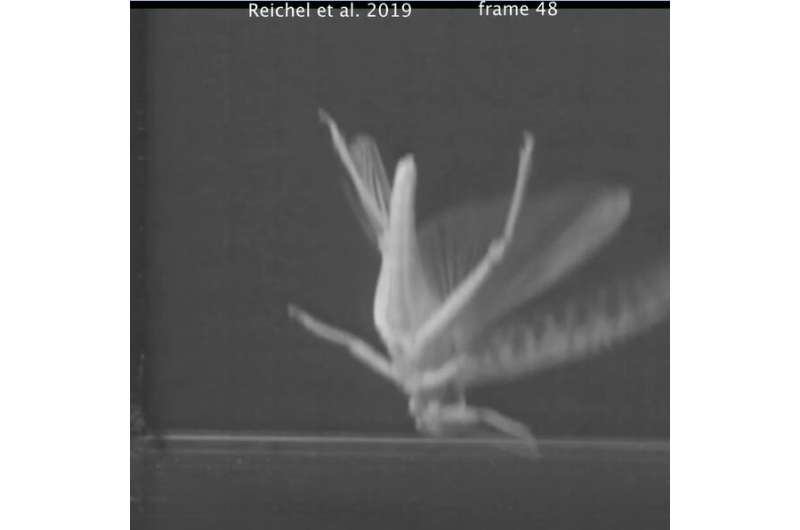For many grasshoppers and other insects jumping is a fast and effective way to escape from their predators. In particular desert locusts are known for their powerful jumps. To avoid catapulting into the wrong direction, locusts are able to precisely control the movement of their prominent hind legs. However, what happens when the locusts want to land? Are they also able to precisely control their landing movements like airplanes do? Do they slow down to prevent damage to their body?
Researchers from the Biomimetics-Innovation-Centre at the Hochschule Bremen (HSB) have now shown for the first time the details of crashing behavior in jumping locusts. Their results published in the current issue of the Journal of Experimental Biology show that falling locusts surprisingly do not show any notable forms of slowing down when approaching the surface, however crashed head-first into the ground.
"We were puzzled not to see any slowing down when the locusts approached the ground." says Simon Reichel, who was part of the research team at HSB. "Instead, the insects always rotated their body in midair. No matter how we held the insect before the fall, they almost always fell head first towards ground."
This stereotypic falling movement of the falling locust leads to a very predictable body posture at impact. "If you know how you will fall, then you can prepare very well for the actual impact." says Reichel. This behavior thus reduces the time to prepare for the next jump and increases the chance to escape from the predator. Interestingly, the head-first impact was also observed in dead locusts, which indicates the passive role of the insect body in controlling the fall. To further test the role of active movements the team also dropped cold locusts. "Cold locusts have only very limited control of their limb movements." says Reichel. "Very similar to a drunk person." Consequently, these cold locusts often showed uncontrolled falling movements. This observation indicates that some degree of active control is required to improves the chances of a controlled crash.
Highspeed recording showing a locusts (S. gregaria) crashing head first onto a substrate. The locusts turn their body midair to ensure a predictable crash onto their head. This behavior allows a quick recovery and preparation for the next escape jump. Credit: Reproduced/adapted with permission of Journal of Experimental Biology, Reichel, S. V., Labisch, S. and Dirks, J.-H., 2019, Journal of Experimental Biology, volume 222, doi:10.1242/jeb.202986
"The cuticle exoskeleton of insects is tough enough to withstand the relatively small forces during the impact." says Prof. Jan-Henning Dirks (HSB). "It thus seems more important for the insect to be able to predict how to crash, instead of reducing the effect of the crash. We believe that our results could be very helpful for engineers faced with for example the problem of landing small objects such as unmanned space probes on unknown terrain." Instead of worrying about slowing down or actively controlling the descent in real time, new bio-inspired probes could be built using a design which always results in a more predictable crash and allows them to quickly recover to proceed with their tasks.
Highspeed recording comparing the falling behavior of alive, cold and dead locusts (S. gregaria). The warm locusts quickly recover to prepare for the next jump, whilst the cold and dead locusts showed far less control of their descent. Credit: Reproduced/adapted with permission of Journal of Experimental Biology, Reichel, S. V., Labisch, S. and Dirks, J.-H., 2019, Journal of Experimental Biology, volume 222, doi:10.1242/jeb.202986
More information: Simon V. Reichel et al. What goes up must come down: biomechanical impact analysis of falling locusts, The Journal of Experimental Biology (2019). DOI: 10.1242/jeb.202986
Journal information: Journal of Experimental Biology
Provided by City University of Applied Sciences























